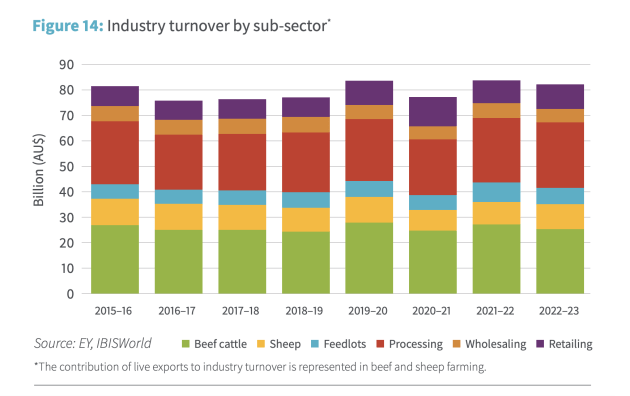Meat & Livestock Australia’s (MLA) latest analysis of the broader market conditions and economic contribution of the red meat industry says 2023 was a year where the industry remained resilient despite volatility.
In its latest State of the Industry report, MLA provides an overview of Australia’s red meat and livestock industry from the prior calendar year. This edition examines the financial year 2022-2023 and calendar year 2023.
MLA’s managing director, Michael Crowley, said following three years of consistent growth, the red meat sector moved into a period of change, with 2023’s turn off resulting in peak production and slaughter numbers across beef cattle, sheep and goats.
“Weather conditions deteriorating in much of the country and a simultaneous declaration of an El Niño and Positive Indian Ocean Dipole (IOD) triggered a significant sap in confidence in the industry, pushing prices to concerning lows in the second half of last year,” said Crowley.
“The industry was able to remain resilient in the face of this instability thanks to strong demand across a diversifying export market and strength in the processing sector.
“In addition, just as prices fell to unexpected lows, the market experienced a form of correction when conditions improved, as much of the country received favourable rainfall as we approached Christmas,” he said.
Industry turnover
In 2022–23, Australia’s red meat and livestock industry turnover was $81.7 billion. This is 2.2 per cent below revised 2021–22 figures, though an increase of 6.3 per cent on 2018–19 figures
New South Wales (28 per cent), Victoria (24 per cent) and Queensland (22 per cent), represent the majority of turnover within the industry, with Western Australia (14 per cent), South Australia (8 per cent), Tasmania (3 per cent) and the Northern Territory (1 per cent) rounding out the remaining turnover.
Red Meat Advisory Council (RMAC) chief executive officer, Susan Wakeford, said that the State of the Industry report highlighted the importance of Australia’s livestock production systems.
“The industry faced an unstable year in 2023 and came out the other side in a strong position with record production and strong export demand from all around the world,” Wakeford said.
“Key to the industry bouncing back after the market downturn halfway through 2023 was the steadying of the domestic labour market and expansion of current and new processing plants which provided growth to Australia’s processing capacity.
“This allowed industry to absorb and manage the surplus of cattle and sheep turned-off over the year, helping industry reach records in both production and slaughter,” she said.
Exports
Red meat and livestock export value rose 3 per cent year-on-year, to total $18.2 billion in 2022–23.
In 2022–23, the value of chilled and frozen meat accounted for nearly 83 per cent of total meat and livestock exports at $14.7 billion, with live sheep and cattle exports accounting for 7 per cent at $1.3 billion. Co-products and further processed exports accounted for the other 10 per cent, valued at $1.7 billion.
In calendar year 2023, Australia was the second largest beef exporter and the world’s largest sheepmeat and goatmeat exporter.
In 2023, Australian beef and veal exports totalled 1.08 million tonnes shipped weight (swt), up 27 per cent year-on-year. The United States emerged as Australia’s largest beef export market (in volume terms) in 2023, totalling 246,000 tonnes.
In 2023, Australian lamb exports totalled 326,014 tonnes swt, the highest on record and 15 per cent above 2022. China became Australia’s largest lamb export destination in 2023 in volume terms, at 66,875 tonnes. While mutton exports totalled a record 209,580 tonnes swt, a 44 per cent year-on-year increase with China accelerating as the number one market at 97,481 tonnes.
Goatmeat exports totalled 33,904 tonnes swt in 2023, up 55 per cent on the year prior. The United States remains the largest destination for goatmeat, accounting for 42 per cent of exports or 14,477 tonnes in 2023.
Domestic consumption
Australia’s per capita beef and sheepmeat consumption continues to be one of the largest in the world. 92 per cent of Australian households purchased beef and 72 per cent bought lamb in the past year.
Australia remains one of the world’s largest consumers of beef, ranked third behind Argentina and the United States, with per capita consumption in 2023 averaging 23.4kg.
Australia was the largest sheepmeat consumer on a per capita basis in 2023 at an average of 7.4kg. Helping to boost lamb consumption over the past year is the falling lamb retail price, which fell below beef in mid-2023.
“Australians love their beef and lamb, and this report emphasises the fact that we are some of the biggest per capita consumers of red meat globally,” Crowley said.
“With 2024 set to break production and slaughter records highlighted in this 2023 analysis, there will be plenty more beef and lamb on the shelves for consumers to enjoy as we approach summer.”
The full 2023 State of the Industry report can be viewed here.







